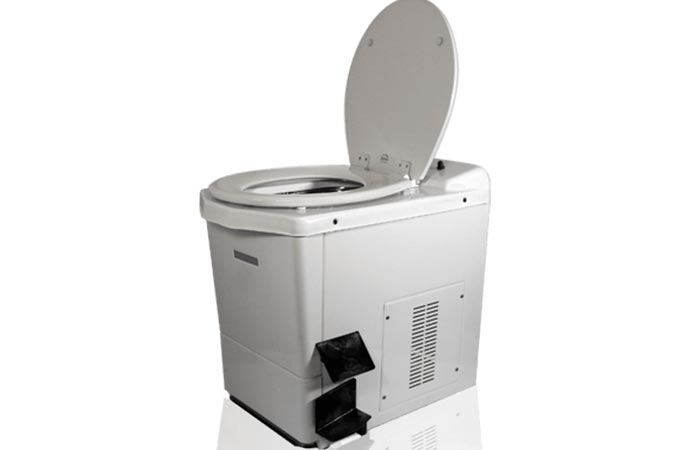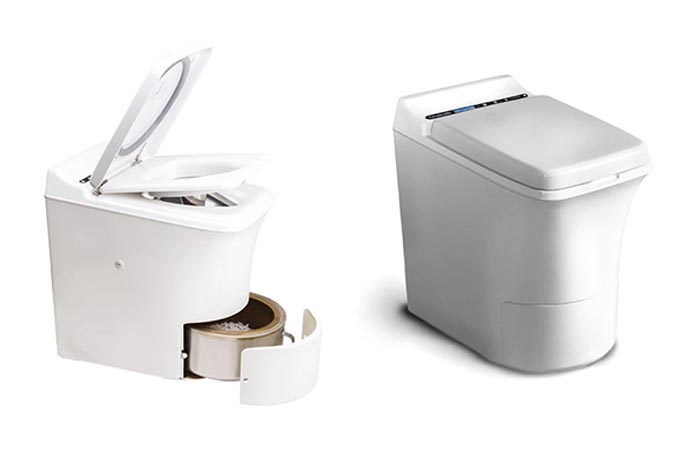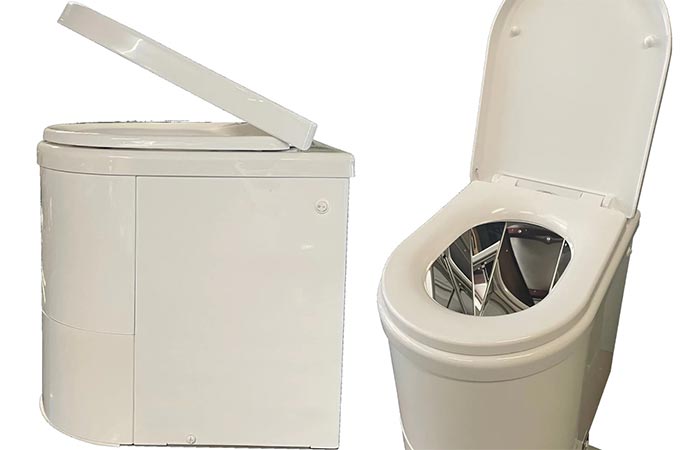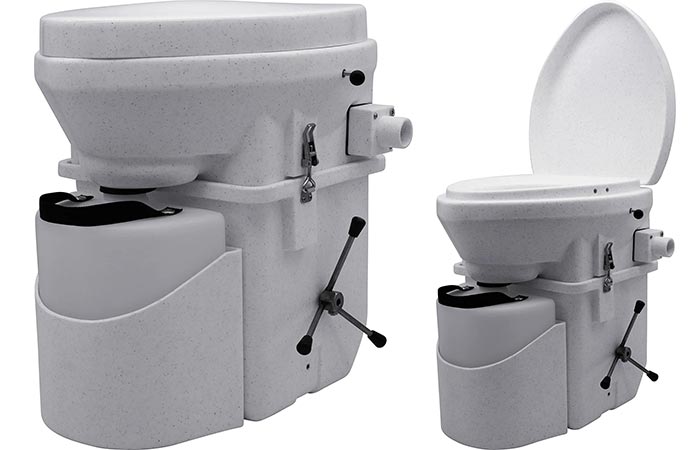Incinerating Toilets Pros and Cons: Comprehensive Guide
An incinerating toilet, is a type of toilet that turns human excreta and urine into vapor and small amounts of sterile ash that can be easily disposed of. Also known as burner toilets, incinerator toilets are gaining popularity as an alternative to conventional and widely used toilets that cannot work without water and a septic/sewer system.
The pros include water-saving, hygienic, odorless, easy to install and use, no plumbing, low-maintenance while cons include costly, require gas/electricity, disagreeable, inconvenient to some users, pollution etc.
If you are thinking about acquiring an incinerator toilet, read on to find out more on the benefits and downsides, how it works, the types including electric and gas(propane), a review of the best, how much they cost and more.
Incinerating Toilet Pros
Burner toilets are gaining popularity because they allow you to get rid of both liquid and solid waste without worrying about storage, transportation, or disposal. Since they are waterless, you require no plumbing to cater to your drainage ne eds.Here are the advantages of incinerating toilets.
Since they do not water to flush the waste, incineration toilets save plenty of water and the resources that would go into recycling wastewater.
Eco-friendly
Natural gas-powered incinerating toilets are an eco-friendly way to get rid of human waste. Needing no water and waste treatment chemicals even makes them safer for the environment.
By recycling waste that would otherwise be disposed of in landfills, they also help to reduce the need for these facilities.
The toilets significantly reduce waste handling by requiring just a small amount of ash to be emptied, and the incineration cycle creates fine, sterile ash that can be put in the garbage or disposed of quickly and safely.
Most incinerating toilets are stand-alone units that require no plumbing or septic system. You can easily install them anywhere, be it in remote areas, either for temporary or permanent use.
Using these toilets is quite easy. All you need for every use is shielding the bowl with a paper line and pressing a button or a pedal to activate the burning process.
Incinerating toilets are also quite easy to keep clean as no water needs to be emptied and the waste matter never comes into contact with the bowl because of the bowl liner. All you need is to empty the ashes after a certain period.
Low Maintenance
Overall, this variation of a waterless toilet requires very little effort from the user. You won’t have to deal with pipes, leaks, or composters.
It only requires you to pull up a little lever that releases all the ashes from inside into an easy-to-empty container.
You can easily carry or move an incinerating toilet because some models are lighter and smaller.
Their portability makes them a reliable option if you travel to places without bathrooms or places that lack suitable septic systems or plumbing fittings.
Because they are not secured to the floor, easily move them out of the way while not in use if you have a small bathroom or storage closet. When remodeling your home, you may also find a place for it without too much difficulty.
Incinerating toilets are renowned for leaving no or minimal foul odors in your home. One reason people prefer this sort of toilet is that there will be no terrible odors lingering in their bathroom throughout the day or night, unlike other forms of septic tanks, which can emit a foul stench when used frequently.
Bug-free
Incinerator toilets don’t attract flies and other bugs as the heat keeps them away and the waste is not exposed in addition to the fact that they are odorless.
Adaptable to Different Climates
You can use incinerating toilets in both warm and cold places, especially in unheated shelters without concern of freezing.
The toilets are intended to function in all climates, including frigid ones. This is one of its main selling factors for those people who reside near the Arctic Circle or other chilly places.
The fewer moving parts in incinerating toilets make them more durable and much longer-lasting than other types of bio-toilets such as composting ones
Incinerating Toilet Cons
The following are the drawbacks of incinerating toilets:
High upfront costs
While incinerating toilets are an excellent alternative to standard WCs and other bio-toilets, they are significantly expensive. Installation, power/gas, and additional items like bowl liners will add extra costs.
Installation
Some components, such as installing a venting system, that are required for incinerating toilets to work properly might require professional assistance.
In some countries and states, you might need a certified venting system that observes health and safety rules to protect you, your property, and the people who live or visit.
Inconveniences
Some of these toilets take a lot of time to incinerate the excrement and during the incineration process, some models won’t allow you to use the toilet. Periodically clearing ash from the area around trap doors due to accumulation over time can also be rather laborious. All these are a significant inconvenience to many users.
Fortunately, there are larger models that can be used up to 60 times before being incinerated and some models can allow use during the incineration process; opening the lid pauses the process and once you close the lid, the process resumes.
Require Gas/Electricity
As mentioned earlier, most of the incinerating toilet brands are either electric or gas powered, which results in higher average energy costs for users.
Pollution
Units are not entirely pollution-free; both portable electric generation (for remote locations) and propane fuel burning produce some air pollutants.
The incineration process is thought to emit harmful gases such as sulfur dioxide, nitrous oxide, carbon monoxide, particulates (including dioxins), heavy metals (such as mercury), polycyclic aromatic hydrocarbons (PAHs), and polychlorinated biphenyls.
You might have to put the system through regular inspections for health and safety reasons.
Extras needed for use
Anti-foam agents, catalysts or other additives are typically required for use.
Impractical Ash
If you are into farming or gardening, the ash from the incineration process won’t be of much help. The process destroys nutrients in the waste, making the by-product(ash) inadequate for replenishing soil nutrients
How does an Incinerator Toilet Work?
Like standard toilets, incineration toilets have a seat and a bowl. However, they do not come with a tank and instead have a sealed burning chamber.
To use this toilet, you must line the bowl with a paper filter supplied by the manufacturer. This keeps the bowl clean by preventing waste from coming into contact with the bowl’s sides.
After using the toilet as usual, you close the lid, release the waste and the bowl liner, and drop them into the incinerating chamber below by pressing a button or stepping on a foot pedal.
Once in the burning chamber, the waste is treated at high temperatures (range between 970 and 1400°F (500-750°C) to dry the organic matter first and then burn the remains.
Unlike standard toilets that rely on water pressure and gravity to flush waste, incinerating toilets rely on electric power or natural or propane gas to burn the waste.
Vapor and gases from the burning waste gases are emitted through a ventilation pipe. This enclosed space makes the system an odorless and highly hygienic way of managing waste.
Propane Incinerator Toilet
This type of incinerating toilet uses propane as fuel to burn both human waste and other items like toilet paper. The waste materials burn, producing carbon dioxide, hydrogen, and methane gas in addition to the residue that is removed as ash.
Propane-powered incinerating toilets also bear an electric function, as they require fans in the exhaust/vent pipe during the incineration process and sometimes in some automated functions.
Depending on the size and how much trash is in the tank, gas incinerating toilets only empty the tank when it is full of ash, and the incineration process can take anywhere between 1 1/2 and 4 hours.
You might have to put the system through regular inspections for health and safety reasons.
Electric Incinerating Toilet
As their name states, electric incinerating toilets are powered by electricity and use electric energy to generate heat and combust waste matter leaving ash as a by-product.
Electric incinerating toilets have an electric heating system which takes about an hour to incinerate the waste. Electric incinerating toilets are the most advanced type of toilet. Some even have built-in fans to help circulate odors out through a venting pipe or roof mount exhaust.
Incinerating Toilet Price
Incinerator toilets cost ranges between $1,200 and $5,000 or more. This price varies depending on brand, model, and size. You may also need to pay a professional to install some components such as the venting system.
Additional running and maintenance costs include the following.
For each use, you have to line the inside of the bowl with a special bowl-shaped paper liner. A package of 200 liners costs about $20. This price varies with the brand or model.
You will also need to pay for fuel to power the incineration chamber. Incinerating toilets are powered by propane, natural gas, or electricity. The energy costs in your area and the frequency of use dictate the total cost for owning and running an incinerating toilet.
Periodic/annual maintenance can also require an expert or new replacement parts.
Best Incinerator Toilet Brands Review
The top and most popular brands of incinerator toilets include incinolet, cinderalla and ecojohn. Following are the details on the models and features.
Incinolet
The original American Incinolet has been regularly improved since 1959. Simply said, Incinolet is the best-selling incinerating toilet in the world and a superb market leader in the United States and Canada.

Incinolet is simple to use and maintain, and it has great reliability. High-quality parts, thoughtful craftsmanship, and a lack of superfluous features have helped achieve this.
INCINOLET TR3500 & TR800 STAINLESS STEEL
| Material | Stainless steel |
| Fuel | Electricity |
| Cost | Four user $2,300; Eight-user $2,700. |
| Width | 31cm |
| Depth | 69cm |
| Height | 54cm |
| Seat height | 51cm |
| Weight | 43cm |
| Capacity | TR1800: 4-5 people TR3500: 6-8 people |
| Ventilation pipe ext. diameter | 110mm |
| Operating Voltage | 220/230v |
| Combustion power | TR1800 1800 W / 10A TR3500 3500 W / 16A |
| Energy consumption kWh. per visit | TR1800 / TR3500 0.5-1 |
| Burn time | 70 minutes |
| Combustion temperature | 540-650oC |
The two types differ in that the Model TR1800 has to be connected to a socket with a 10A fuse, or a regular socket fuse, while the Model TR3500 needs to be connected to a 16A fuse.
The incinolet combustion toilet is suitable for use in both heated and chilly rooms. Incinolet toilets are best suited for almost all bathroom fixtures and even recreational vehicles.
Cinderella Incinerator Toilet
With 25 years of experience and being on the market, Cinderella’s water-free incinerator toilets are famous for their performance and sustainable, environmentally friendly design that emits no pollutants..

Cinderella Freedom, originally known as Cinderella GAS, is a propane-powered, water-free incinerator toilet that burns all waste at high temperatures with very little sterile ash produced. It is particularly designed for locations with little or no access to electricity.
Cinderella Freedom, like all toilets made by the Cinderella Eco Group, doesn’t require sewage or water, saving you money on sewage connections. The toilet is simple to install and has an intuitive LCD display that informs and notifies the user when the ash bin needs to be emptied. Seven different languages can be selected for the display.
| Material | Stainless steel |
| Cost | $ 4 130 |
| Height | 23 ⅝” |
| Seat height | 21 ¼” |
| Weight | 75lbs (34kg) |
| Fuel | Propane |
| Maximum weight tolerance | 440 lbs |
| Width | 15 ⅜” |
| Depth | 23 ¼” |
| Capacity | 4 visits per hour |
| Ventilation ducts/pipes | 110 mm (ULC-S636) |
| Gas consumption | 160-190 grams per incineration |
| Standby Power Consumption | 0.005 Amp |
| Power consumption (incineration) | 1.3 Amp |
| Maximum Burner effect | 9260 BTU/h (2,87 kw) |
| Power requirements: | 12V DC 11–14.4V, 4 Amp M |
- Bowl liners
- Foot rest
- Liner holder steel
- Maintenance kit
- Root feedthrough
- Ventilation installation kit
Features Cinderella Incinerating toilets
- Ideal for locations with no mains electricity or where gas is preferable
- No need for 230V mains power and only needs a 12V DC power source, a propane gas supply, and inlet/outlet air
- LCD display with information
- straightforward ash container emptying
- a complete garbage solution with no after-treatment
Ecojohn
Ecojohn models are all made in Arkansas, USA. To assure high quality and optimum performance, each product is subjected to a number of testing processes. Furthermore, all purchases are shipped on a pallet to ensure that the products arrive to the buyer in good condition and without any shipping problems.
- TJ-P12 – Propane, 12V DC
- TJ-P240 – Propane, 240V AC/12V DC Dual (12V DC Backup Capability)
- TJ-P120 – Propane, 120V AC/12V DC Dual (12V DC Backup Capability)
- TinyJohn
| Fuel | Propane Gas (LPG)/Natural Gas |
| Average price | $3,385.00 |
| Operating Voltage | 12V DC, 120V AC, 240V AC |
| Material | Steel |
| Height | 22” |
| Width | 14” |
| Depth | 19” |
| Sitting depth | 20 ⅝” |
| Weight | 65 lbs |
| Electrical Load | 12V DC: 1.5 Amp/hr 120V AC: 17 Watt/hr |
| Propane Consumption | Urine Cycle: 0.09 lbs/cycle Waste Cycle: 0.19 lbs/cycle |
| Overall Propane Gas Consumption: | Approx. 150 Flushes / 5 Gal BBQ Propane Tank |
Ecojohn’s TinyJohn is a compact and sleekly constructed waterless self-contained gas fired toilet that incinerates waste into sterile ash. It is a popular choice for off-grid cabins and can even work at higher elevations.
TinyJohn models have environmental, economic, and logistical advantages and are ideal for situations where a normal toilet would be impractical to construct.

- Liners Dispenser
- Vent Kit
- Bowl Liners (100 liners/box)
- Propane Hose (5ft to 12ft)
- Catalytic Converter – The toilet vent system also incorporates a catalytic converter, which cleans the air going outdoors and reduces odors (if any). It also keeps the exhaust fan clean and requires minimal upkeep.
Incinerator Toilets RVs
An incinerating toilet is one of the best ways to manage waste in RVs. They are an ideal choice since they are portable, water-free, and you can easily install them without a plumbing or drainage system. They are also hygienic, odorless, and require little maintenance.
However, they need a source of power for the burning process. The good thing is that you only use energy when incinerating waste. You do not have the worry about the smoke getting into your RV as they have a venting system.
The EcoJohn “TinyJohn” is the best choice for RVs because it can run off highly portable propane gas. The Incinolet is also a splendid choice if you have access to electricity or a generator.
These options can also be used in other vehicles, including vans, caravans/trailers, campervans, as well as boats
Other Applications/Uses of Incinerator Toilets
- In rural locations without a municipal sewage system, or in areas where installing septic systems would be impractical, expensive, or impossible because of shallow soils, steep slopes, high groundwater levels, or extremely cold weather.
- Apartments with limited or difficult access to waste plumbing, such as remote roadside rest sites where connecting to a piped sanitary system is impracticable and expensive.
- For construction teams and crews working in locations without permanent restrooms. Human waste must either be treated before release or be held in tanks while at sea on marine boats, where it is illegal to dump untreated waste into bodies of water. For instance, incinerating toilets work well on yachts and canal barges instead of blackwater holding tanks, which must occasionally be pumped out.
- In locations where water is scarce owing to drought or other environmental factors, the necessity to preserve water stimulates the consideration of alternate, water-free toilet systems.
- Where community, environmental, and health organizations have concerns about existing sewage disposal practices, particularly seepage of contaminants into local water supplies from improperly functioning septic or other treatment systems, or residents’ exposure to improperly dumped waste products from rudimentary collection pails.
Incinerating Toilet vs Composting Toilet
The major difference is that an incinerating toilet burns the waste into a small amount of ash residue immediately after toilet use, while composting toilets employ nature’s composting process to break waste down.
While an incineration toilet needs electricity or a gas source to function, meaning they are energy- inefficient while composting toilets are energy efficient since they rely on nature’s composting process.
The incineration process waste is cleaner and faster compared to the nature-dependent composting process, which takes a lot of time and is unhygienic.
The ash produced from an incinerating toilet is of no value, while the compost from composting toilets looks like soil and can be used for different purposes.
Incinerator toilets are expensive but produce minimal smell and require low maintenance, while a composting toilet is cheaper but requires more work and might produce a greater smell.
Similarities
Both systems are completely odor-free and require little to no water to operate, making them perfect for unheated locations prone to freezing.
Composting and incinerating toilets are both cost-effective, practical, and environmental-friendly ways to keep your septic system in good working order.
They are among the few ideal toilets that you can deploy in places where regular toilets are inoperable.

DIY Incinerating Toilet?
To some crafty individuals, it may seem like all you need to create an incinerating toilet is a source of heat, preferably a heat gun, and a strong enclosed medium (like a stainless-steel pot) in which the waste can burn.
In general, creating your own incinerating toilet at home is not recommended mainly because of safety concerns. Incinerating toilets use high temperatures to burn waste, which can produce harmful emissions if not properly designed and installed.
In addition, building your own incinerating toilet could be dangerous due to the risk of fires and explosions.
If you are sure that an incinerating toilet is the most suitable choice for needs, it is a good idea to buy one from any of the qualified manufacturers mentioned above.
If you cannot afford, there are many other alternative waste management options like composting toilets or black tanks. These options are cheaper, safer and more environmentally friendly.
Remember, it is always best to consult with a professional or research local regulations before making any changes to your waste management system.
Do Incineration Toilets Require Maintenance?
Like any other equipment, incineration toilets require maintenance. The most common maintenance task is regular emptying and cleaning of the ash collection pan or container.
Other maintenance tasks depend on the type(gas/electric) of incinerator toilet you have. The tasks can include;
- Cleaning of the outer stainless steel surfaces including the bowl halves.
- Periodic cleaning of the blower motor with occasional replacement of the blower wheel.
- Cleaning and lubrication of the foot pedal mechanism.
- Annual cleaning of the combustion chamber, exhaust pipe and venting system to eliminate dust and ash particles, which might stop the system from functioning correctly.
- An annual inspection of the catalyst.
Can you Pee in an Incinerator Toilet?
Yes. You can pee in an Incinerating toilet. The toilets are designed to be able to incinerate and completely combust all waste matter from the human body. That is, both solid waste and liquid waste(urine). In addition, they can combust a few other biodegradable waste options like toilet paper etcetera.
Liquid waste(pee) however takes lesser time to get incinerated and thus most toilets come with two options for incinerating solid and liquid waste separately
Do Incinerating Toilets Stink?
Incinerating toilets only emit a slight burning odor shortly after you turn on the incinerator, but it dissipates quickly and is less than the odor produced by a composting toilet. Depending on the wind, there may be some odor from the exhaust vent outside, but this quickly dissipates. Choosing the proper venting location reduces odors.
How often do you have to Empty an Incinerator Toilet?
To maintain an incinerating toilet, you’ll need to empty the ash periodically. The frequency of emptying depends on the type of toilet and should take between a day and a week depending on the usage and size of toilet.
For convenience, you should estimate the time the ashtray gets half full depending on the usage, and remove and dump the ashes before the tray becomes full.
References
- https://ossf.tamu.edu/incinerating-toilet/
- https://www.epa.gov/sites/default/files/2015-06/documents/incinera.pdf
- https://www.cinderellaeco.com/articles/31/what-is-an-incineration-toilet
- https://incinolet.com/how-it-works/
- https://incineratingtoilets.com/ca/faq/
- https://en.wikipedia.org/wiki/Composting_toilet